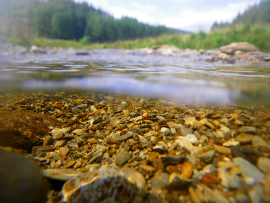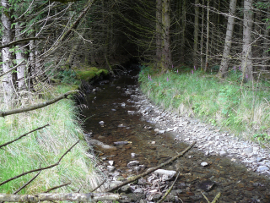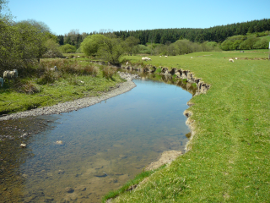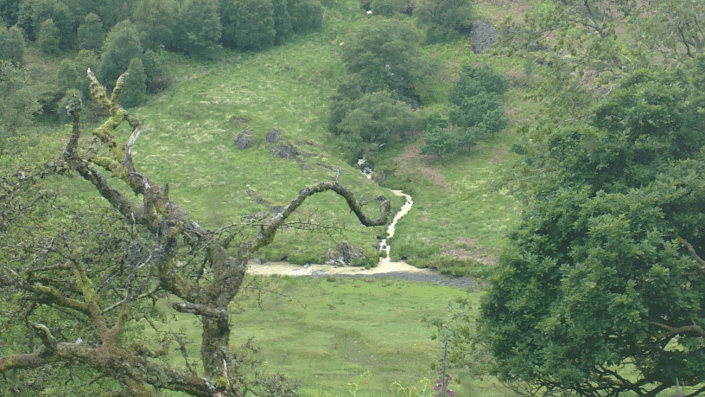Issues & Threats
While climate change and acidification have national/international causes, the majority of threats to the Irfon have come from land use intensification and inappropriate management of the riparian zone.
Acid Waters
Critical loads for acid deposition were, and still are, exceeded across one third of the Welsh uplands, most significantly over the Cambrian massif. Despite recent falls in Sulphur and Nitrogen deposition in precipitation, upland locations in the Cambrian massif still receive 15-25 kg S/ha/yr and 20-25 kg N ha/y. Acidification is exacerbated by conifers, especially spruce and pine planted on base-poor soils, and recovery is retarded. Periodic acidification still occurs widely, even in streams where mean pH is increasing. In the upper Irfon catchment during the autumn and winter, pH commonly falls after rainfall to 3.9-5.0, with aluminium concentrations reaching over 0.1 mg /L.

Streams in the Irfon catchment and elsewhere have groups of diatoms and invertebrates that are characteristic of acidified streams. Acidification was a clear pressure on the Irfon Special Area of Conservation (SAC) at the start of the project.
Acid waters impact on SAC features both physiologically, such as gill damage to fish, and also ecologically by suppressing assimilation of organic detrital material into the food chain.
Rates of recovery from the effects of acid deposition are being carefully monitored in directly adjacent catchments.
This monitoring has shown that mean H+ concentrations in acid moorland streams fell by c. 15-16 µquiv/1 over the last 25 years, increasing mean winter pH in grassland streams by 0.8-1.3 units to pH 5.6-6.1. In acid forest streams, H+ reductions µ(8-15 µquiv l-1) were similar, but mean winter pH H+ increased by only 0.4 units (mean pH 4.8- 5.2; Al > 0.3-0.6 mg l-1) thereby offsetting any biological recovery.
The primary impacts are on salmon and bullhead, both of whose range should extend into the acid areas. Salmon alevins are killed by pHs below 5.5. Recent evidence suggests low pH also affects the osmoregulation ability in salmon smolts (and so impairs their ability to adapt to salt water when migrating to sea). Bullhead are not found in water courses whose pH drops to less than 5.5.
White clawed crayfish have historically been recorded in the Irfon's middle reaches but the mild acidification of these areas (pH 6.3-6.5) is the probable cause for them being confined to only the very lowest reaches of the catchment.
Overgrazing
Sheep numbers doubled in the upper Wye catchment during the 1990s and despite temporary reductions post foot and mouth, numbers are now back to historically high levels. Commonly, water courses are farm boundaries and, as such, one side is fenced and the other side grazed. The problems were entrenched in the previous Common Agricultural Policy (CAP) when the river bed was included as part of the grazable area (and needed to be grazed!) when calculating farm subsidy payments.
Overgrazing of the riparian zone reduces riparian sward depth and the ability of river banks to withstand the effects of spates. As a result the river widens and shallows and sediment is introduced exacerbating siltation. The wide, shallow river is more impacted to low flows and temperature extremes. The complete exclusion of stock from a stream typically leads to a narrowing of 30%.
Foot and mouth meant an almost complete cull of the sheep flock in 2001. Despite the new single farm payment taking away the incentive to overstock, the high meat prices since then have meant stock numbers have returned to inappropriately high levels.
The physical damage to streams caused by overgrazing impacts detrimentally on almost all SAC features.


Overgrazing on the South Dulas (right) and the Cerdin, an Irfon tributary affected by overshading (far right).
Overshading
Until the late 1960s all the streams in the Irfon had their riparian alder coppiced for firewood, charcoal and clog making. This tree management stopped abruptly and the resultant multistem coppice regrowth created dense, multi-level shading on much of the tributary system.
Tunnelled trees suppress bankside vegetation and in river algal production, widening and shallowing the channel and leading to a trophic switch from grazing to detrital feeding invertebrates. The latter are much less prone to 'drift' which is 98% of the food source of juvenile salmon. Research in Ireland has shown that had 400m of tunnelled vegetation will reduce downstream juvenile salmon numbers to almost 0.
This is a problem that continues to exacerbate. The solution is to reduce these multiple stems to single trees by coppicing. An additional benefit is that new trees can grow (if also fenced) and existing trees are more stable and resistant to toppling.
Siltation
The fine silt loadings in the Irfon remain relatively low but, in common with the rest of the rivers in the area, they have more than doubled due to a mix of increased intensity of land use practices (grazing and forestry). The practice of commercial forestry is to provide deep drainage channels down slopes thus increasing "flashiness" and increments to silt burden. Grazed slopes reduce water ingression and, combined with over shading and overgrazing of streams, the problems of siltation are exacerbated and in extremis. Sediments can fill the interspaces of river gravels, welding them together.
Siltation affects egg hatching rates in spawning gravels by smothering them. The transportation of silt from one part of the SAC may affect another area downstream. Invertebrate communities are adversely affected in taxa diversity and numbers. Much of the phosphate (which raises trophic status) and pesticides that damage the SAC enter it attached to fine soil particles.
The problem is one that worsens with the extremes of climate change, high stocking densities and failure to take remedial action. Salmon, bullhead and other fish are all adversely affected, as are freshwater pearl mussel, other molluscs and invertebrates and thus, indirectly, species further up the food chain such as otter.

Pesticides pollution
Until recently sheep dip frequently entered these watercourses. Acid waters are poor buffers, making the problem worse in the Irfon. Despite the recent removal of Synthetic Pyrethroids (SP) from the veterinary approved list, stocks of the chemical remain. SPs are still widely used in the forest areas during the early stages of tree establishment. Organophosphates are still approved for use on livestock. These toxic substances enter watercourses either deliberately or accidentally. The current trends are for declining usage.
In very low concentrations these chemicals are lethal to white clawed crayfish. They also act adversely on salmon and bullhead by both diminishing invertebrate food supply and also as endocrine disruptors. Salmon spawning and migration is affected by as little as 1 part of SP per trillion.
Invasive species
Our white clawed crayfish cannot coexist with the American signal crayfish, which compete with the native species and sometimes carries plague. Currently there is a 24km buffer between the nearest population of signals (which is downstream and being controlled) and the Irfon. Invasive weeds damage bank integrity as described with overgrazing and over shading. Rivers and streams are highly effective disseminators of invasive weeds. In the absence of effective treatment trends are that the negative effects of invasives will worsen. Of the SAC species, white clawed crayfish are the highest at risk.
Climate Change
Climate change is predicted to cause more extremes of temperature and flow, the extent and mechanism of which is complex and subject to many influences. Extremes of flow will always have a temporally negative effect and the trend is likely to be for more frequent and longer periods of drought. All species and habitats are affected to some extent.
| Natura 2000 code | Species/habitat | Acid waters | Overgrazing of riparian corridor | Excessive shade | Siltation | Flows and modifications | Sheep dip pollution | Invasive species | Climate Change |
| 3260 | Ranunculion fluitantis and Callitrcho-Batrachion vegetation | ||||||||
| 1029 | Margaritifera margaritifera | ||||||||
| 1092 | Austropotamobius pallipes | ||||||||
| 1095 | Petromyzon marinus | ||||||||
| 1097 | Lampetra planeri | ||||||||
| 1096 | Lampetra fluviatilis | ||||||||
| 1103 | Salmo salar | ||||||||
| 1106 | Alosa fallax | ||||||||
| 1163 | Cotus gobio | ||||||||
| 1355 | Lutra lutra |
Table 1. showing relative impacts of detailed threats on SAC features withihn the Irfon.
Red=High Orange=Medium Yellow=Low Green= No threat
